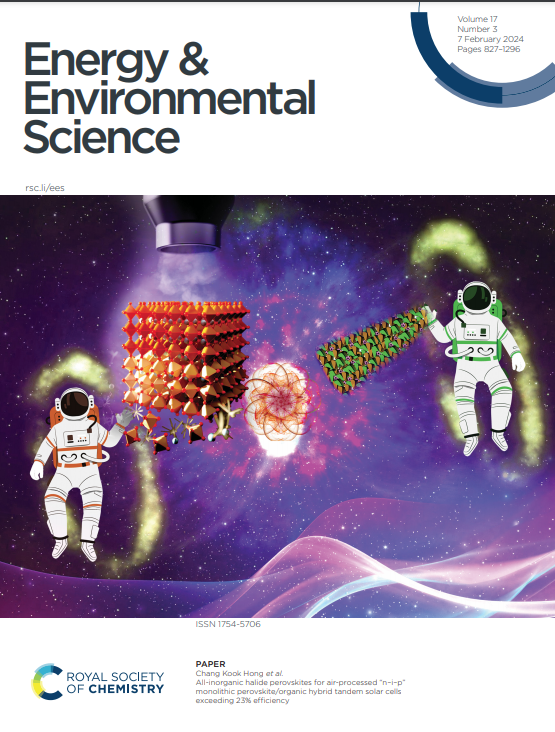A donor: hole-transport layer alloy for high-efficiency and stable binary organic solar cells with promoted hole collection and suppressed recombination
IF 32.4
1区 材料科学
Q1 CHEMISTRY, MULTIDISCIPLINARY
引用次数: 0
Abstract
Charge collection efficiency is primarily dependent on the interface layer in organic solar cells (OSCs), minimizing the recombination at interface can effectively suppress energy losses. A persistent challenge remains in the development of hole-transport materials that can establish intimate contact with organic photoactive materials, primarily due to their hydrophilic nature. Here, we incorporated water-based nanoparticles (NPs) containing donor material into the conventional PEDOT:PSS to fabricate the hole-transport layer (HTL) in OSC devices. This strategy creates an extensively intermixed donor:PEDOT:PSS alloy, which optimizes the work function, reduces energy loss, and significantly increases the interface area between the HTL and the photoactive layer. The alloy formation promotes high crystallinity in the active layer, facilitating charge collection and suppressing non-radiative recombination. OSCs based on this approach, particularly those using PM6:L8-BO, achieved an efficiency of 19.9 % (19.3 % certified). Inverted device retained 95 % of its initial efficiency after 1600 hours of continuous illumination, marking one of the best stability records for PM6:L8-BO-based OSCs. This novel approach addresses the incompatibility issues between solution-processed HTLs and active layers in OSCs, offering significant promise for future advancements in organic solar cell research about interface engineering.用于高效稳定双元有机太阳能电池的供体:空穴传输层合金,可促进空穴收集并抑制重组
电荷收集效率主要取决于有机太阳能电池(OSC)中的界面层,最大限度地减少界面层的重组可以有效抑制能量损失。开发能与有机光活性材料建立亲密接触的空穴传输材料仍是一项长期挑战,这主要是由于它们的亲水性。在这里,我们在传统的 PEDOT:PSS 中加入了含有供体材料的水基纳米粒子 (NPs),以制造 OSC 器件中的空穴传输层 (HTL)。这种策略产生了一种广泛混合的供体:PEDOT:PSS 合金,它优化了功函数,减少了能量损失,并显著增加了 HTL 与光活性层之间的界面面积。合金的形成促进了活性层的高结晶度,有利于电荷收集并抑制非辐射重组。基于这种方法的 OSC,特别是使用 PM6:L8-BO 的 OSC,效率达到 19.9%(认证效率为 19.3%)。倒置器件在连续照明 1600 小时后仍能保持 95% 的初始效率,这标志着基于 PM6:L8-BO 的 OSC 具有最佳稳定性。这种新方法解决了溶液处理 HTL 与 OSC 中活性层之间的不相容问题,为未来有机太阳能电池的界面工程研究带来了巨大的发展前景。
本文章由计算机程序翻译,如有差异,请以英文原文为准。
求助全文
约1分钟内获得全文
求助全文
来源期刊

Energy & Environmental Science
化学-工程:化工
CiteScore
50.50
自引率
2.20%
发文量
349
审稿时长
2.2 months
期刊介绍:
Energy & Environmental Science, a peer-reviewed scientific journal, publishes original research and review articles covering interdisciplinary topics in the (bio)chemical and (bio)physical sciences, as well as chemical engineering disciplines. Published monthly by the Royal Society of Chemistry (RSC), a not-for-profit publisher, Energy & Environmental Science is recognized as a leading journal. It boasts an impressive impact factor of 8.500 as of 2009, ranking 8th among 140 journals in the category "Chemistry, Multidisciplinary," second among 71 journals in "Energy & Fuels," second among 128 journals in "Engineering, Chemical," and first among 181 scientific journals in "Environmental Sciences."
Energy & Environmental Science publishes various types of articles, including Research Papers (original scientific work), Review Articles, Perspectives, and Minireviews (feature review-type articles of broad interest), Communications (original scientific work of an urgent nature), Opinions (personal, often speculative viewpoints or hypotheses on current topics), and Analysis Articles (in-depth examination of energy-related issues).
 求助内容:
求助内容: 应助结果提醒方式:
应助结果提醒方式:


